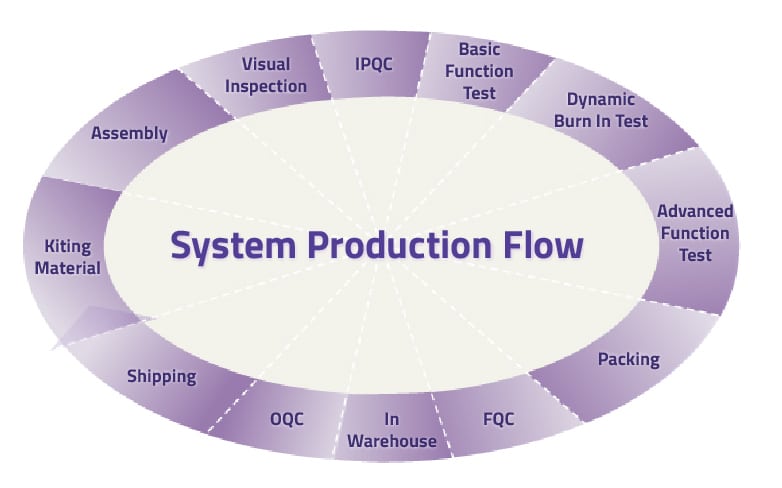Portwell’s system production flow is engineered to ensure stable quality, repeatability, and reliable performance from assembly to shipment. The process begins with Assembly, where every system component—main boards, cables, fans, HDDs, and related accessories—is properly installed and verified. Visual Inspection follows, checking workmanship and component placement to prevent early-stage defects and ensure that all accessories are correctly prepared before testing.
During IPQC, each production stage is monitored against defined standards to maintain specification consistency throughout the build. The systems then undergo a Basic Function Test, validating essential electronic functions prior to more intensive evaluations.
A critical reliability step, Dynamic Burn-In Test, subjects the system to operational stress conditions. This test screens potential weaknesses and early-life failures, helping ensure system stability across varied environments. Afterward, an Advanced Function Test is performed to confirm full operational readiness and product performance after burn-in.
Once testing is completed, the process moves into Packing, where all accessories are placed into protective bags and securely boxed. FQC performs a final quality check based on standard procedures to verify product completeness. OQC executes structured sampling to validate shipment quality before release.
The workflow concludes with Shipping, where optimized handling, palletizing, and stretch-wrap procedures enhance logistics efficiency and protect products during transportation.
Through this streamlined production flow, Portwell consistently delivers dependable, high-quality systems designed to meet industrial-grade requirements.

Makes certain that all the system components were assembled properly (Main board, Cable, Fan, HDD, etc.)

Once systems have been assembled, they will have already been visually inspected. Our inspectors ensure all components and accessories are assembled properly and follow MFG before testing.

Verifies that all the production processes are completed correctly and accordingly to specification.

In order to ensure the system product is able to boot up by Dynamic Burn-In, 100% of the system products are tested for electronic functionality via a Basic Function Testing after assembly.

DBI is the test used before the product is shipped out. The purpose is to screen possible weaknesses and failures which affect its reliability under different environments.


This procedure is to ensure the quality and functionality of the system product after the Burn-in test.

We inspect the product for external defectiveness. Once they have passed, we then collocate all accessories into plastic bags then proceed with boxing and labeling.

Finished and packed goods are placed in this area for inspection; the FQC department will inspect finished goods based on standard procedures.

To implement QC inspection procedure on packaged and finished goods, OQC has the MIL–STD 105E Table. QC staff conducts sampling according to required sampling by quantity.
In order to meet the demands of storage, transportation, loading and unloading the products mechanically, our pallet stretch wrap machine is designed to enhance production efficiency and prevent damage to the products during transportation.
For a deeper understanding of our manufacturing technologies, engineering workflows, and industry-specific know-how, we welcome you to contact our team.
Portwell provides comprehensive insights into advanced system/board production, AIoT integration, and smart manufacturing deployment—along with successful real-world implementation cases across industrial applications.
Our experts are ready to support your next project with professional guidance and technical consultation.